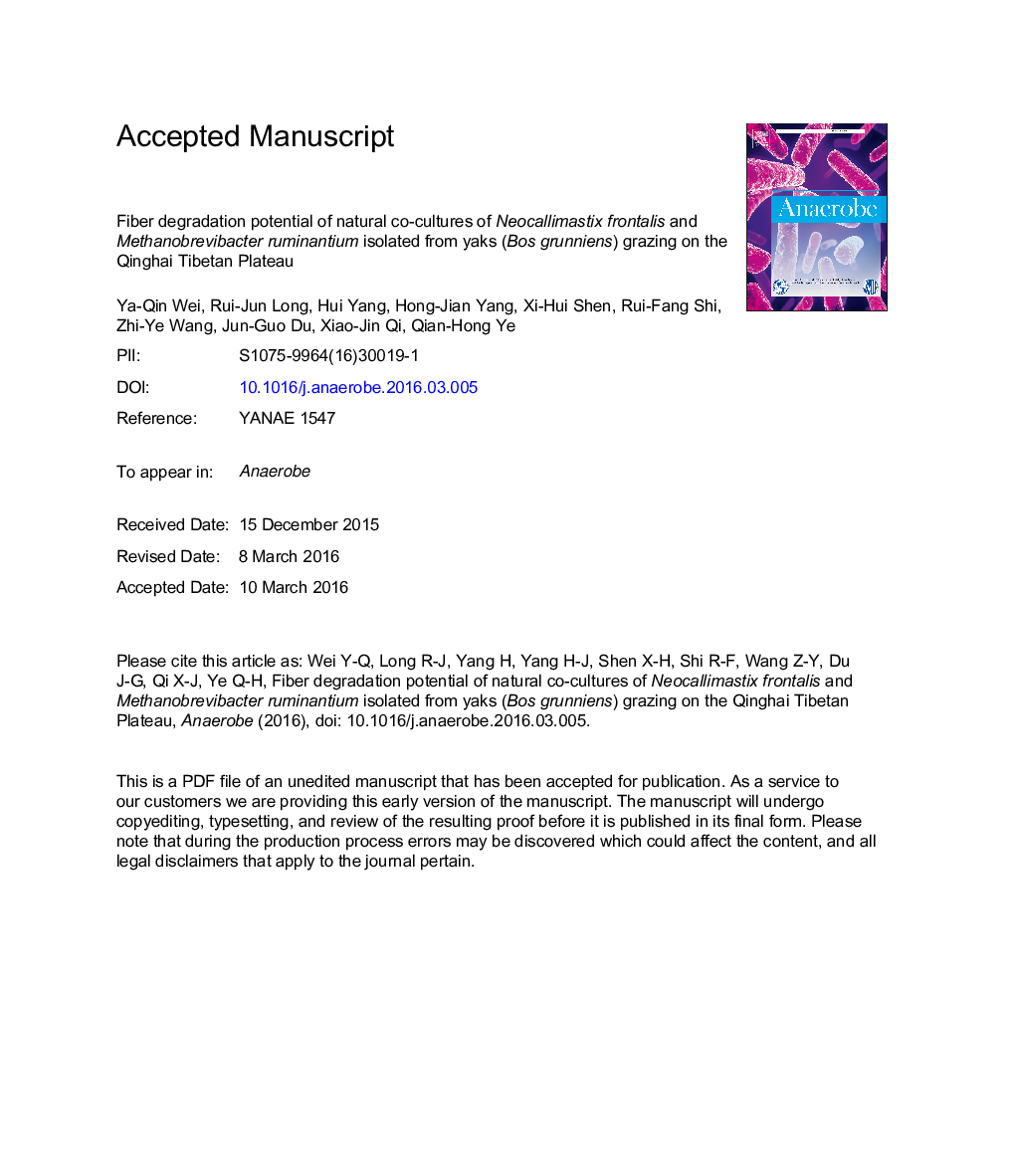| کد مقاله | کد نشریه | سال انتشار | مقاله انگلیسی | نسخه تمام متن |
|---|---|---|---|---|
| 6128598 | 1592825 | 2016 | 29 صفحه PDF | دانلود رایگان |
عنوان انگلیسی مقاله ISI
Fiber degradation potential of natural co-cultures of Neocallimastix frontalis and Methanobrevibacter ruminantium isolated from yaks (Bos grunniens) grazing on the Qinghai Tibetan Plateau
دانلود مقاله + سفارش ترجمه
دانلود مقاله ISI انگلیسی
رایگان برای ایرانیان
کلمات کلیدی
موضوعات مرتبط
علوم زیستی و بیوفناوری
ایمنی شناسی و میکروب شناسی
میکروب شناسی
پیش نمایش صفحه اول مقاله

چکیده انگلیسی
Several natural anaerobic fungus-methanogen co-cultures have been isolated from rumen and feces source of herbivores with strong fiber degrading ability. In this study, we isolated 7 Neocallimastix with methanogen co-cultures from the rumen of yaks grazing on the Qinghai Tibetan Plateau. Based on morphological characteristics and internal transcribed spacer 1 sequences (ITS1), all the fungi were identified as Neocallimastix frontalis. The co-cultures were confirmed as the one fungus - one methanogen pattern by the PCR-denatured gradient gel electrophoresis (DGGE) assay. All the methanogens were identified as Methanobrevibacter ruminantium by 16s rRNA gene sequencing. We investigated the biodegrading capacity of the co-culture (N. frontalis + M. ruminantium) Yaktz1 on wheat straw, corn stalk and rice straw in a 7 days-incubation. The in vitro dry matter digestibility (IVDMD), acid detergent fiber digestibility (ADFD) and neural detergent fiber digestibility (NDFD) values of the substrates in the co-culture were significantly higher than those in the mono-culture N. frontalis Yaktz1. The co-culture exhibited high polysaccharide hydrolase (xylanase and FPase) and esterase activities. The xylanase in the co-culture reached the highest activity of 12500 mU/ml on wheat straw at the day 3 of the incubation. At the end of the incubation, 3.00 mmol-3.29 mmol/g dry matter of methane were produced by the co-culture. The co-culture also produced high level of acetate (40.00 mM-45.98 mM) as the end-product during the biodegradation. Interestingly, the N. frontalis Yaktz1 mono-culture produced large amount of lactate (8.27 mM-11.60 mM) and ethanol (163.11 mM-242.14 mM), many times more than those recorded in the previously reported anaerobic fungi. Our data suggests that the (N. frontalis + M. ruminantium) Yaktz1 co-culture and the N. frontalis Yaktz1 mono-culture both have great potentials for different industrial use.
ناشر
Database: Elsevier - ScienceDirect (ساینس دایرکت)
Journal: Anaerobe - Volume 39, June 2016, Pages 158-164
Journal: Anaerobe - Volume 39, June 2016, Pages 158-164
نویسندگان
Ya-Qin Wei, Rui-Jun Long, Hui Yang, Hong-Jian Yang, Xi-Hui Shen, Rui-Fang Shi, Zhi-Ye Wang, Jun-Guo Du, Xiao-Jin Qi, Qian-Hong Ye,